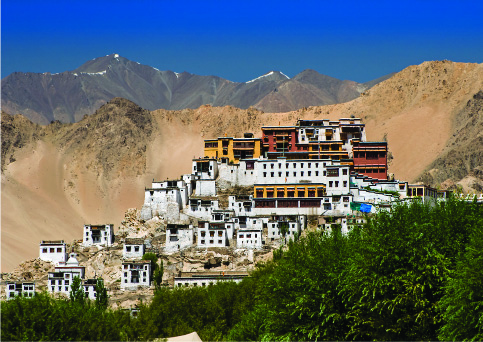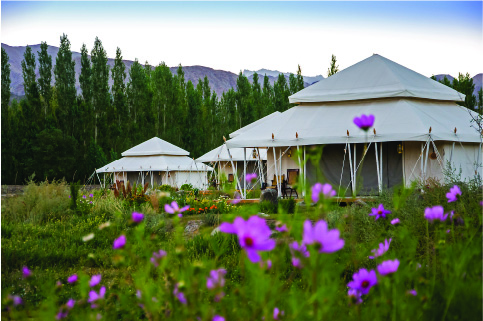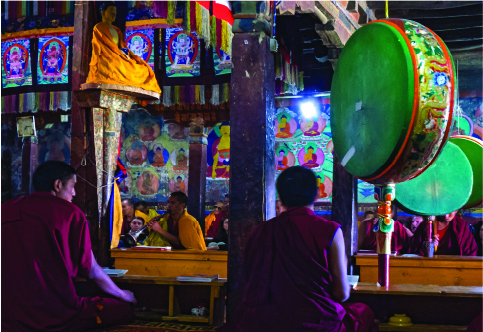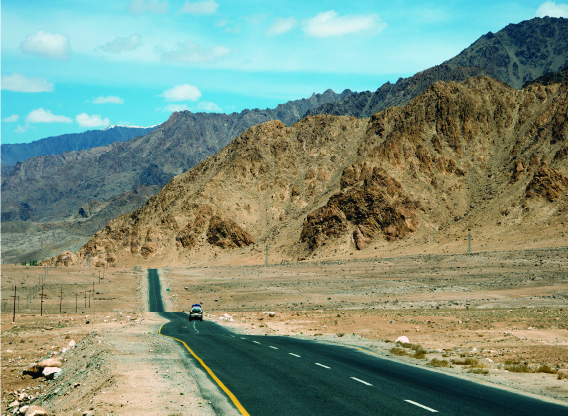Could the landscape unravelling way below our aircraft be the handiwork of a hyperactive mountain God or even a creative devil? Ladakh, the most geographically isolated union territory in the country, secreted between the folds of the Himalayas and the Karakoram range, is a mighty eyeful. We can never get enough of its harsh, surreal topography, even after several trips to this high-altitude desert.
Our plane landed in Leh, the capital, and as we drove to our hotel, the stark beauty of the landscape that swept past us socked us between the eyes: retina-searing vistas of mountains, brown, barren and rough-textured, seemingly gouged in places by a vampire’s finger nails, or daubed with swirling colours of pink, dark chocolate, purple, blue… Ladakh is not your typical summer getaway. Jagged peaks seemingly at ease with their massive girth can be overwhelming plus the air is rarefied at 11,500 ft and more, so that even the fittest can feel breathless and experience waves of nausea on the first day in this sky- high haven.

So, a day of rest was on our agenda, we were told on checking in at the swish Chamba Camp Thiksey in Ladakh (a half hour drive from Leh). Local belles clad in traditional garb welcomed us even as a gilded world of glamping or glamourous camping embraced us. The grounds were dotted with 13 tents kitted out in lux safari camp style and pitched by the side of stone-paved, flower-embroidered paths. A butler was always on hand to cater to our whims. We savoured sumptuous meals in a chandeliered tent and, on one occasion, dined in the shadow of ancient floodlit chortens. But the awesome views of Thiksey Monastery, cascading down a mountain slope in the distance, was a stern reminder of a more lasting world of pure spirituality as versus the transient temporal world which we inhabited.
The next morning, we awoke blurry eyed to attend early morning prayers at Thiksey monastery, huffing and puffing up the steep steps alongside red-robed monks who clambered up like agile mountain goats. On an open terrace, two monks stood like cut-outs against a deep blue sky, raked by saw-toothed peaks. They stood motionless with long, curved copper trumpets even as the first rays of the sun leant a rosy hue to the landscape of fissured behemoths that dared to flirt with the sky. The deep sounds of trumpets were followed by calls on ornate conch shells which ricocheted across the muscular mountains, making us feel like we were floating on a sea of sound unfettered by earthly gravity.

The trumpets had awakened the other monks from blissful slumber and soon they filed into a red-pillared hall to take their place at low red tables. We sat in a hushed corner with a handful of tourists, admiring the tangkas (Buddhist wall paintings) and murals even as low chants accompanied by the pounding of drums seemed to echo our thudding heartbeats. The spiritual tableau was akin to a web of magic in which we were entrapped, emerging only after the sonorous chanting and the pounding drums had died down to a tranquil and total absence of sound.
Indeed, our excursions in Ladakh often made us feel like we were suspended between earth and sky and halfway to heaven… vast blues skies dotted with fleecy clouds; the barren, desiccated landscape and a blazing sun created glowing indelible images while the sudden appearance of apricot and apple groves added dollops of colour. Ladakh is one of the last outposts where Tibetan Buddhism is still practised and its monastery-strewn landscape often made us feel that we had left vast teeming India behind.
Yet everywhere we went – from the vendors in Leh bazaar hawking rugs, apricots, shawls and tangkhas to the farmers and yak herdsmen we encountered – they all seemed happy to see us. Soon Jullay (hello in the local language) became an overused word in our lexicon. Restaurant owners and chefs looked on indulgently as we savoured crisp yet fluffy butter-slathered Ladakhi bread (a kind of crisp round roti), bit into delectable momos, slurped thukpa, a rich noodle soup and sipped butter tea in small intimate cafes and hole-in-the wall eateries where we channelled the flavours of Ladakh and its inimitable vibe.
We never tired of the almost unforgiving, unyielding beauty of a region, buffeted by nature and once bludgeoned by invaders from the neighbourhood – the Dogras of Jammu, the Baltis and Kashmiris. Yet Ladakh does not show the wounds of its blood-soaked history; instead, it is swathed in a palpable serenity, hugged by bare mountains, lush valleys and some of the highest mountain passes in the world. Here hilltop gompas or monasteries wreathed in incense and Tibetan chanting bear evocative names like Shey, Thiksey and Likir; these multi-tiered houses of worship, strung with colourful prayer flags, seem to tumble off the mountain slopes; and green oases are edged by poplars and willows, flower along the banks of the Indus and the Zanskar rivers.

We revelled in the melting pot appeal of Leh, traversed over the centuries by caravans from faraway lands and touched in spirit the wizened monks and nuns who spun prayer wheels as they strolled and prayed; hardy Ladakhi women bore toddlers on their backs or tilled the fields and vegetable gardens outside their pretty white-washed homes…
Ladakh is generous when it comes to dishing out surprises for the visitor to revel in. And our most uplifting and heart-stopping experience happened in the little village of Sospol in the home of a mystic, better known as the Oracle. We sat in the drawing room of the Oracle’s simple home, even as the diminutive lady bustled around in preparation for the elaborate ceremony, lighting a lamp, arranging bowls full of powdered barley, etc… She donned a traditional kimono-like dress over her salwar-kameez, tied a scarf on her head and over her mouth before commencing the ceremony.
A hush descended on the room as she started to sing, pray and hiss, and emitted short screams while tremors raked her frail frame. After half an hour of chanting, bowing and praying, she turned unseeing eyes towards us, and the interpreter (her neighbour) asked us to frame a question which she could answer. We did and the Oracle answered in a high-pitched voice in Tibetan which her neighbour translated it into Ladakhi and our guide in turn into English. A mother who had brought her sick, wailing infant to the Oracle for succour, left beaming; and what astonished us was that the three-month old infant stopped crying and a contented smile lit her face, too!
A strong insistent feeling of having arrived in another world swept over us yet again. We re-lived in memory our excursions to secretive monasteries, festooned with prayer flags, where red-robed monks steeped in prayer and spirituality, were a reminder of the fact that temporal pleasures are impermanent; and to search for permanence in the material world is futile. The monks bore an indefinable air of otherworldliness, echoes of which we found everywhere – from the raw power of Ladakh’s bruised mountains to its lush valleys and fulsome rivers.
Fact File
Leh is connected by air with Delhi and one can travel by road to Leh from either Srinagar (434 km) or Manali (474 km). Leh has luxury accommodation like the centrally heated Grand Dragon Ladakh as well as the Chamba Camp Thiksey, the “ultimate travelling camp” which moves to other destinations after the Ladakh season ends (June to September). There are plenty of mid-range hotels, guest houses and home stays as well in Leh and elsewhere.
For more information, especially re Covid 19 protocols, visit the website of Administration of the Union Territory of Ladakh https://ladakh.nic.in/tourism


 [/column]
[/column]